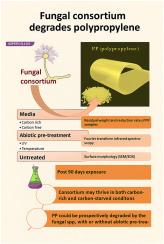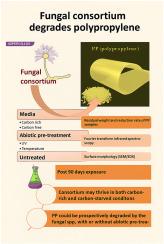一群曲霉生物降解聚丙烯塑料
IF 7.3
2区 环境科学与生态学
Q1 ENVIRONMENTAL SCIENCES
引用次数: 0
摘要
近年来,全世界越来越意识到塑料污染的严重问题,以及它对环境日益增加的危害。本研究使用了一组真菌物种;黑曲霉,黄曲霉和米曲霉降解聚丙烯(PP)塑料,有无非生物预处理(UV,热)在实验室环境中富碳和无碳培养基中生长。经过90天的孵育,温度预处理的PP的失重率达到23.3%,未处理的PP的失重率达到16.66%。与对照组相比,PP样品的表面发生了明显的变化。在第10天和第90天,PP样品中发现了明显的化学变化,通过FTIR验证并量化为碳指数(CI),说明氧化聚合物的分裂。SEM显微照片显示颗粒的脆弱和原子O/C比值估计的合理氧化程度证实了真菌财团的生物降解能力。尽管碳供应的存在提高了效率,但关键发现强调,该联盟可能在富含碳和缺乏碳的条件下茁壮成长。此外,有/没有非生物预处理,PP可能会被真菌降解,强调生物过程作为解决塑料废物管理的可持续策略的相关性。本文章由计算机程序翻译,如有差异,请以英文原文为准。


A consortium of Aspergillus species biodegrades polypropylene plastic
In recent times, there has been increased worldwide awareness on the grave issue of plastic pollution, and its ever-increasing peril to the environment. The present study used a consortium of fungus species; Aspergillus niger, Aspergillus flavus and Aspergillus oryzae for the degradation of polypropylene(PP) plastic with and without abiotic pre-treatment(UV, thermal) grown in a carbon rich and carbon free media in laboratory settings. Post 90-day incubation period, the weight loss of PP reached 23.3 % with temperature pre-treatment and 16.66 % in untreated PP. The PP samples showed substantial surface changes compared to the control group. Marked chemical alterations in PP samples were identified on the 10th and 90th day, validated by FTIR and quantified as carbon index(CI) illustrating the oxidative polymer scission. SEM micrographs revealed the particles' frailty and plausible oxidation degree estimated by the atomic O/C ratio corroborated the biodegradative capability of the fungal consortium. Although the presence of a carbon supply enhanced the efficacy, the key finding underlines that this consortium may thrive in both carbon-rich and carbon-starved conditions.
Additionally, PP could be prospectively degraded by the fungal spp. with/without abiotic pre-treatment, underlining the relevance of biotic process as a sustainable strategy to resolve plastic waste management.
求助全文
通过发布文献求助,成功后即可免费获取论文全文。
去求助
来源期刊

Environmental Pollution
环境科学-环境科学
CiteScore
16.00
自引率
6.70%
发文量
2082
审稿时长
2.9 months
期刊介绍:
Environmental Pollution is an international peer-reviewed journal that publishes high-quality research papers and review articles covering all aspects of environmental pollution and its impacts on ecosystems and human health.
Subject areas include, but are not limited to:
• Sources and occurrences of pollutants that are clearly defined and measured in environmental compartments, food and food-related items, and human bodies;
• Interlinks between contaminant exposure and biological, ecological, and human health effects, including those of climate change;
• Contaminants of emerging concerns (including but not limited to antibiotic resistant microorganisms or genes, microplastics/nanoplastics, electronic wastes, light, and noise) and/or their biological, ecological, or human health effects;
• Laboratory and field studies on the remediation/mitigation of environmental pollution via new techniques and with clear links to biological, ecological, or human health effects;
• Modeling of pollution processes, patterns, or trends that is of clear environmental and/or human health interest;
• New techniques that measure and examine environmental occurrences, transport, behavior, and effects of pollutants within the environment or the laboratory, provided that they can be clearly used to address problems within regional or global environmental compartments.
 求助内容:
求助内容: 应助结果提醒方式:
应助结果提醒方式:


